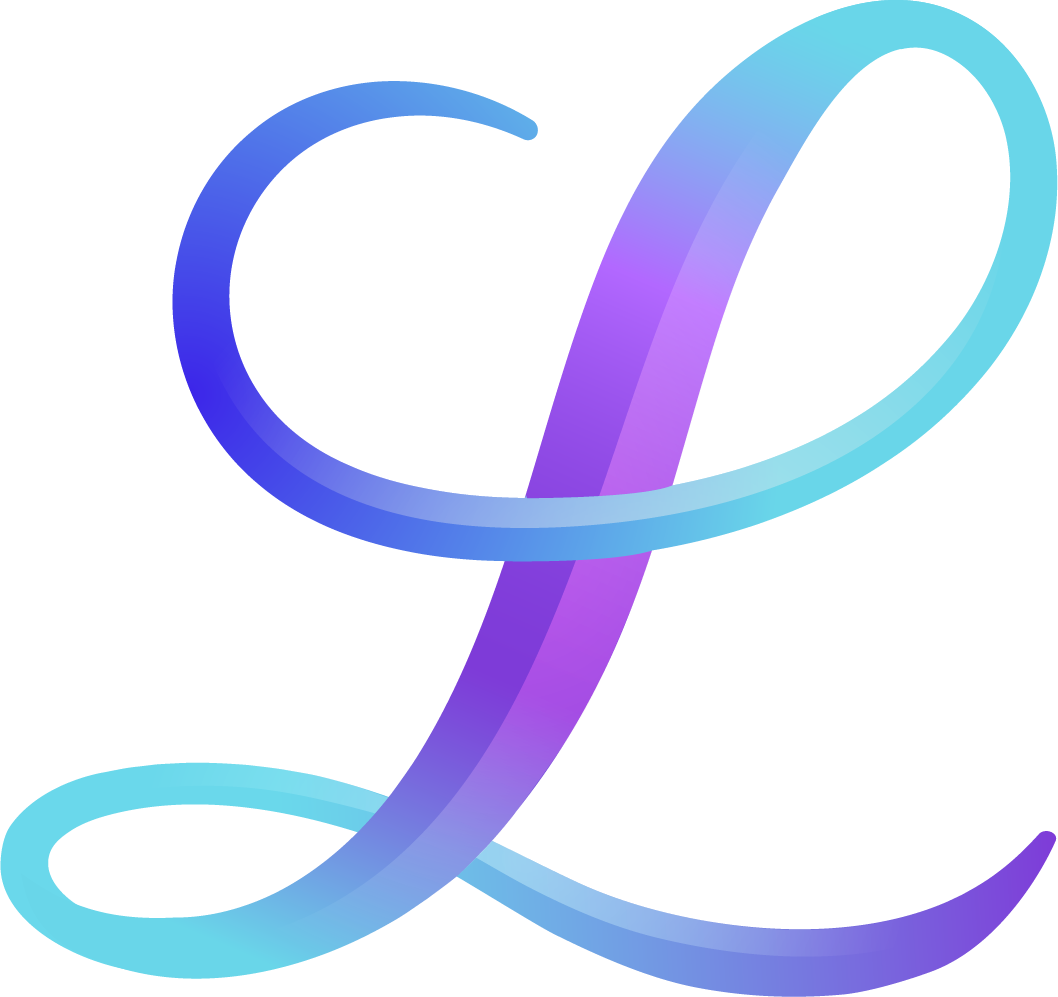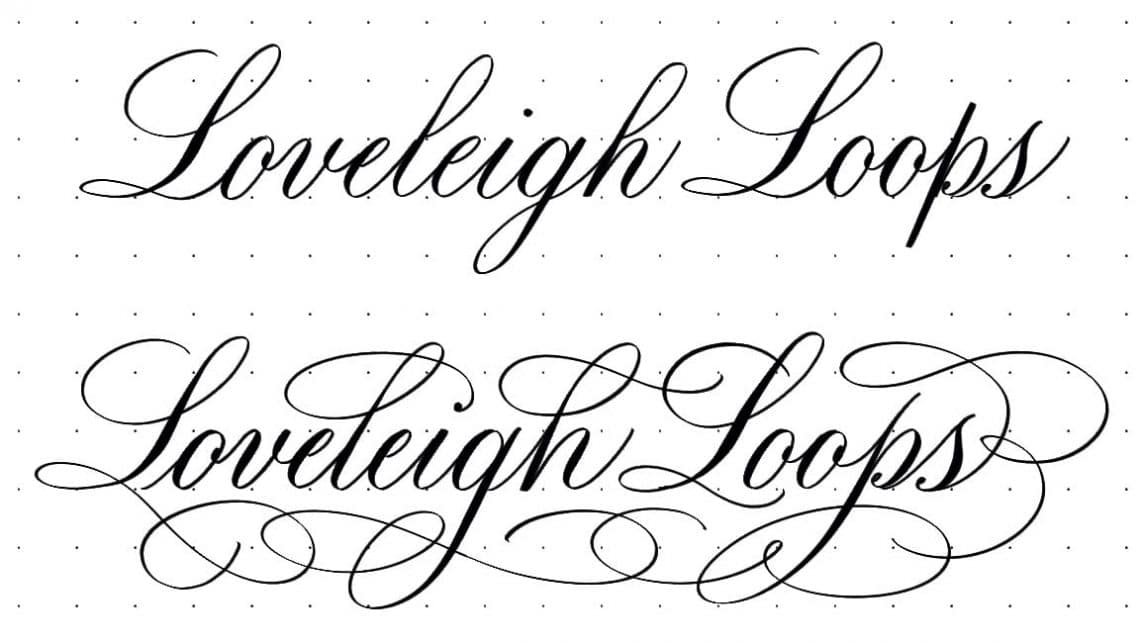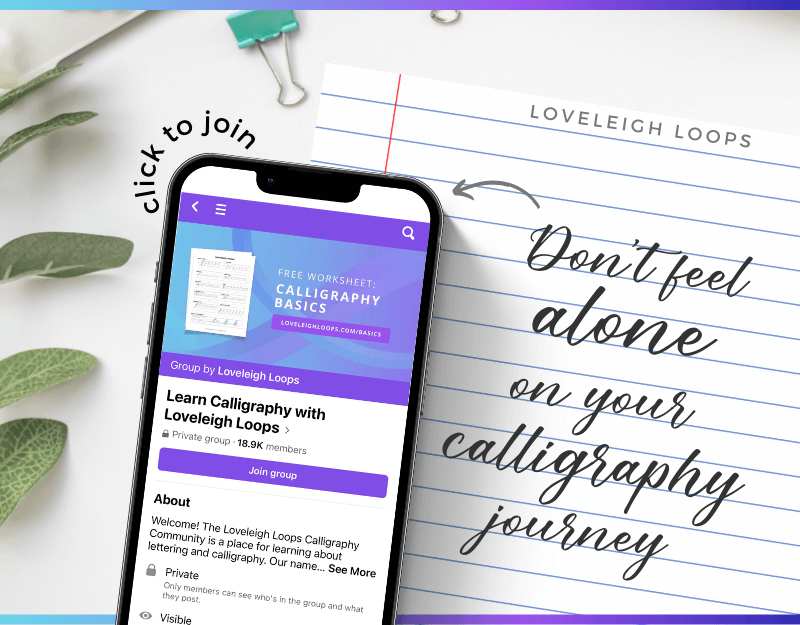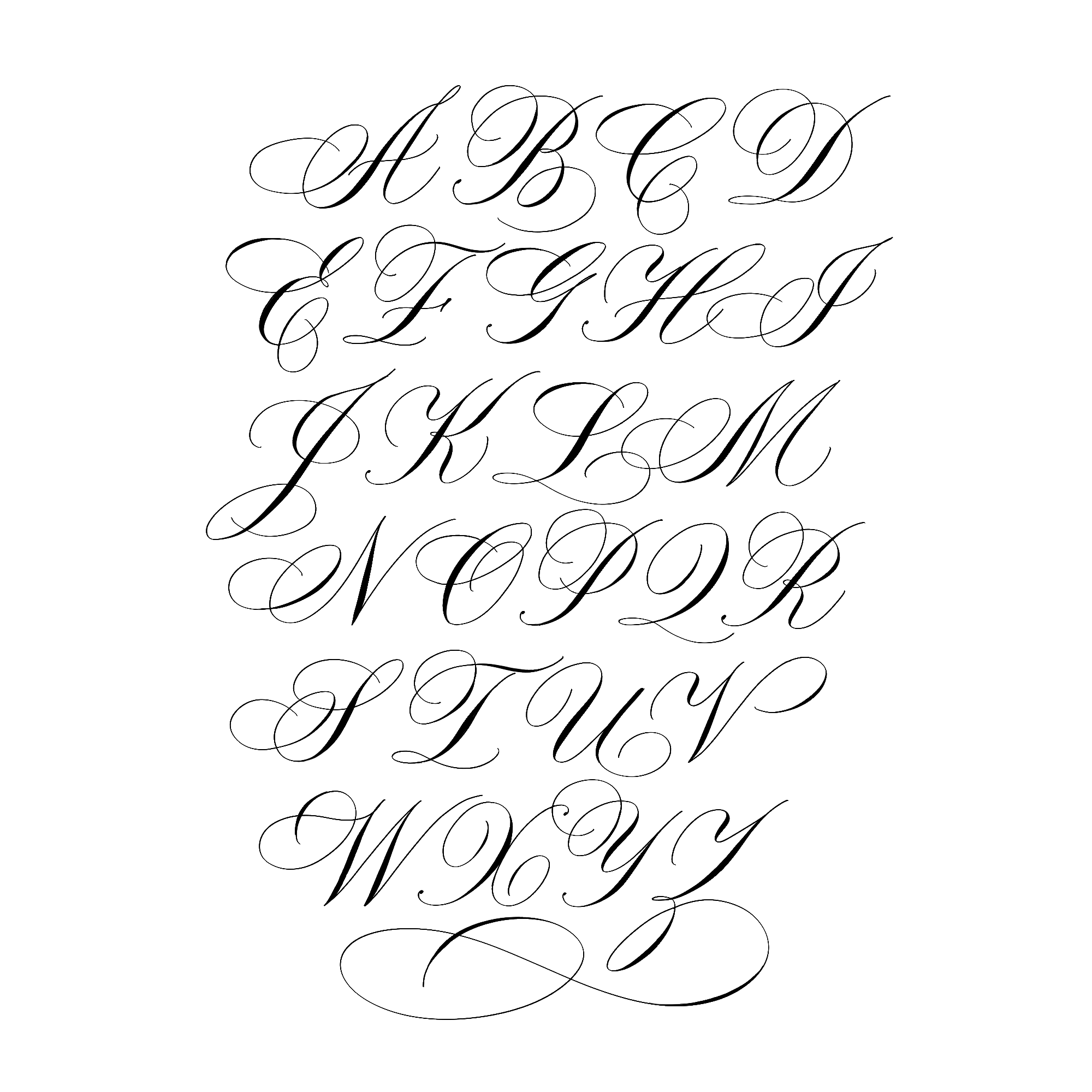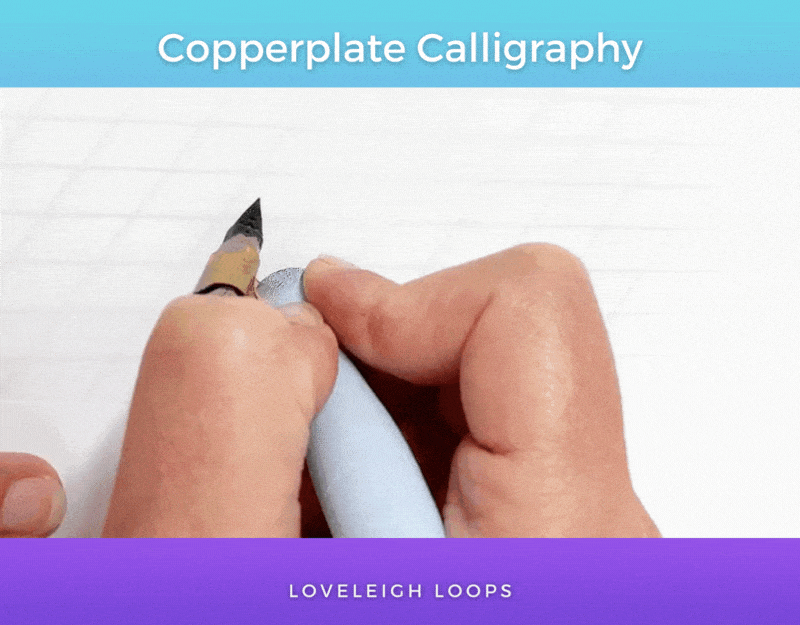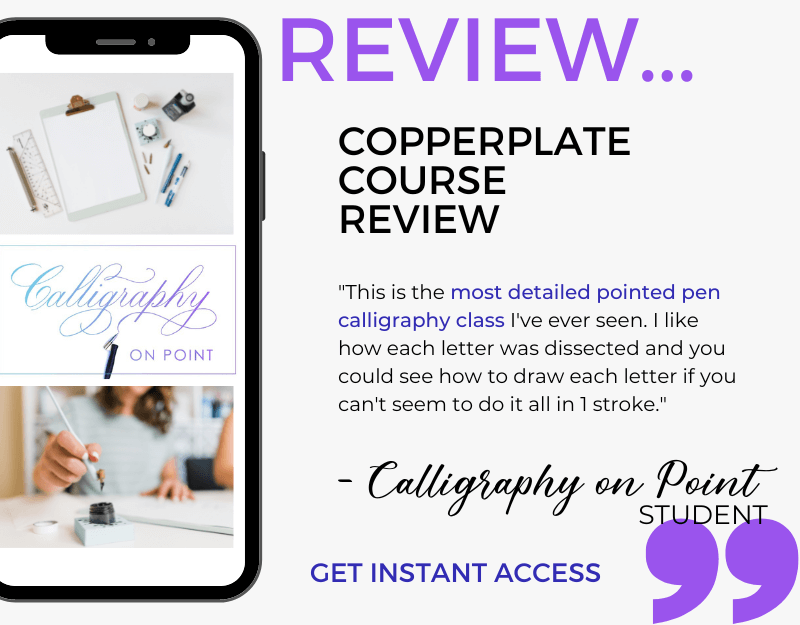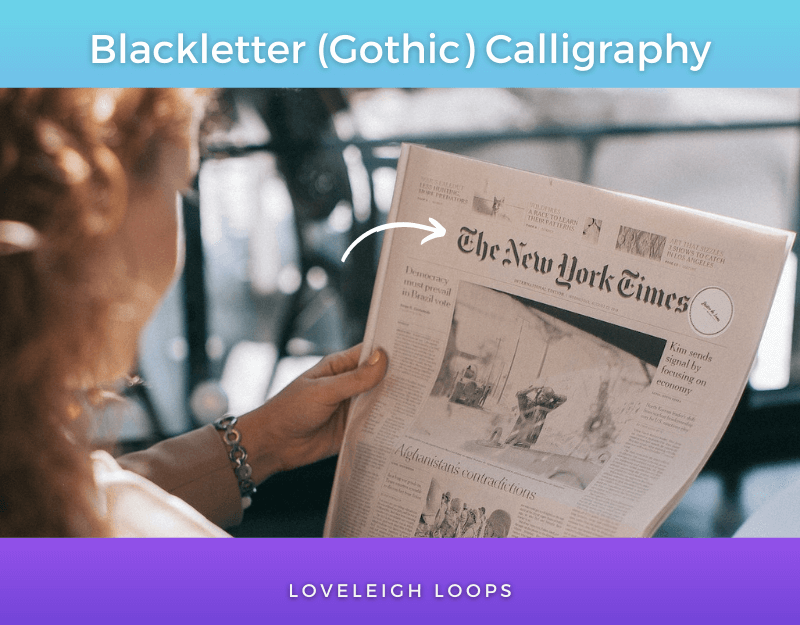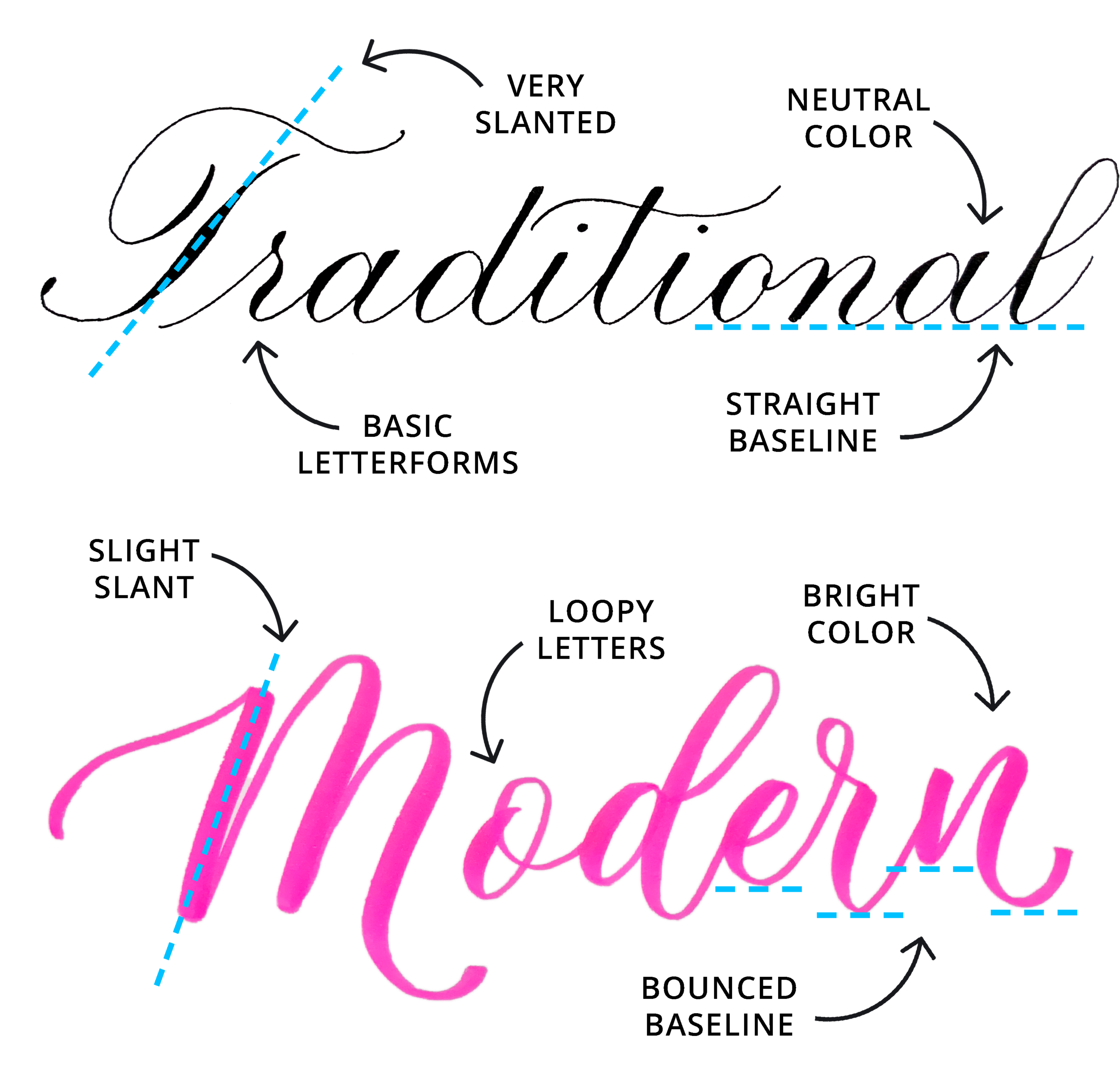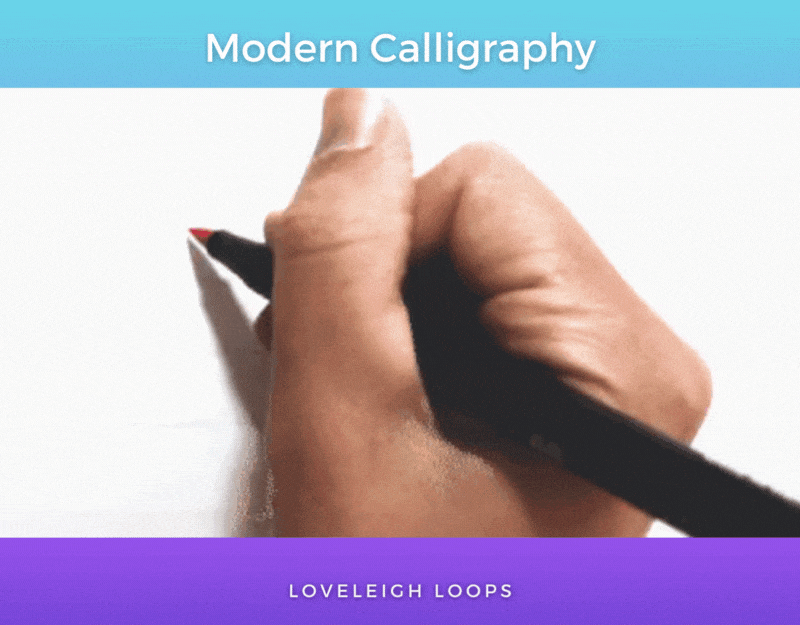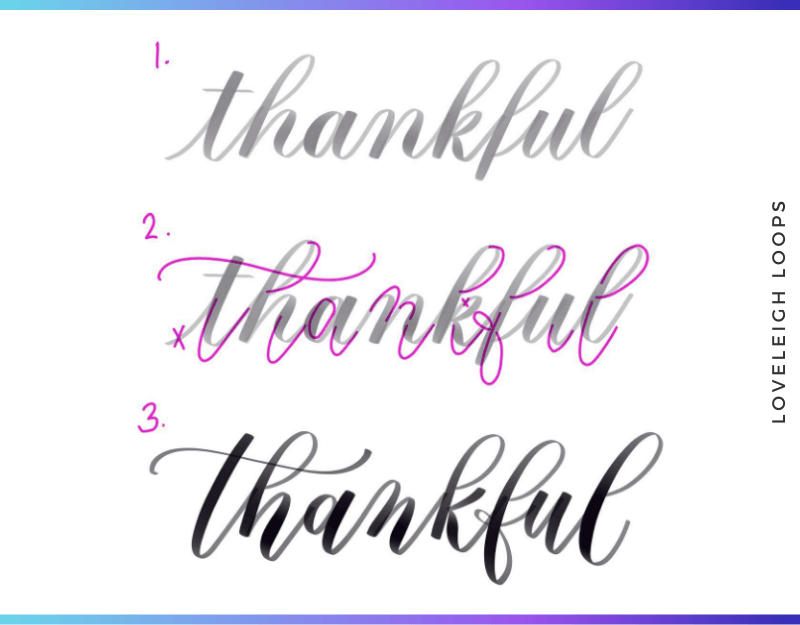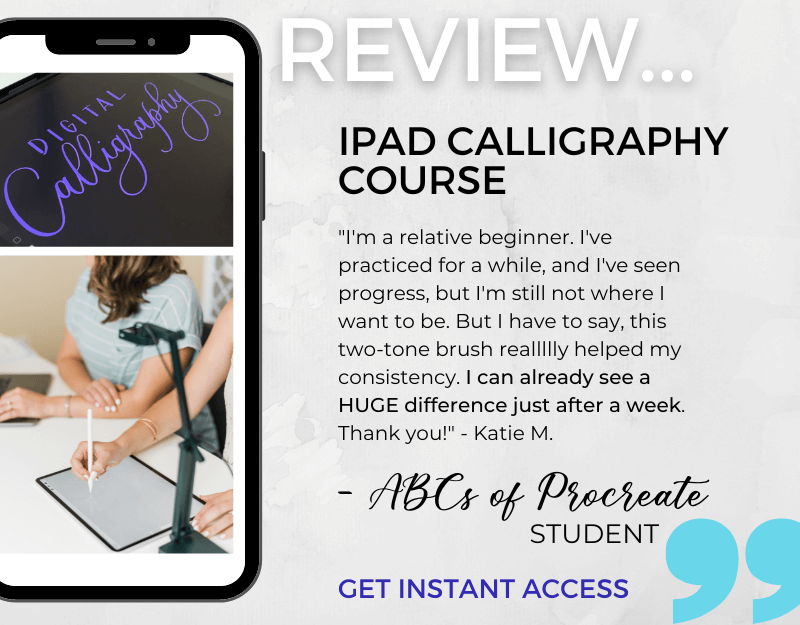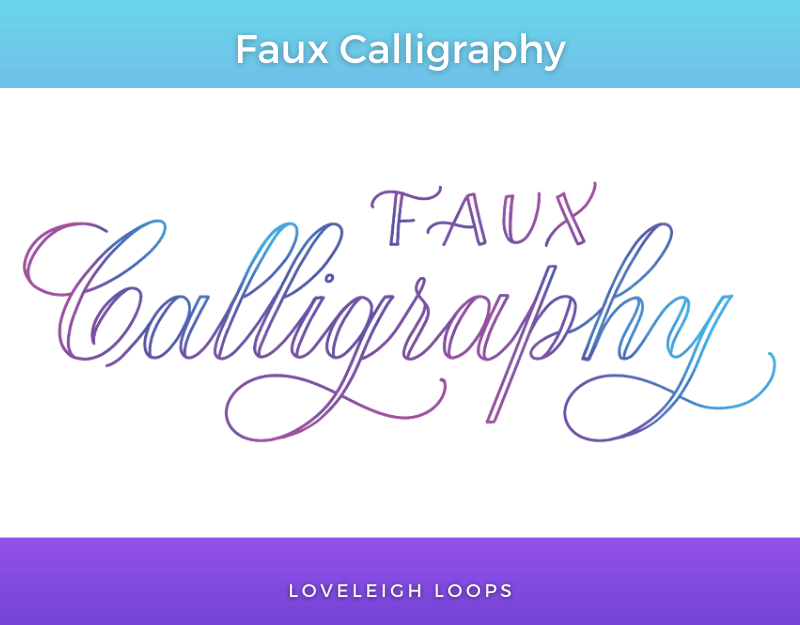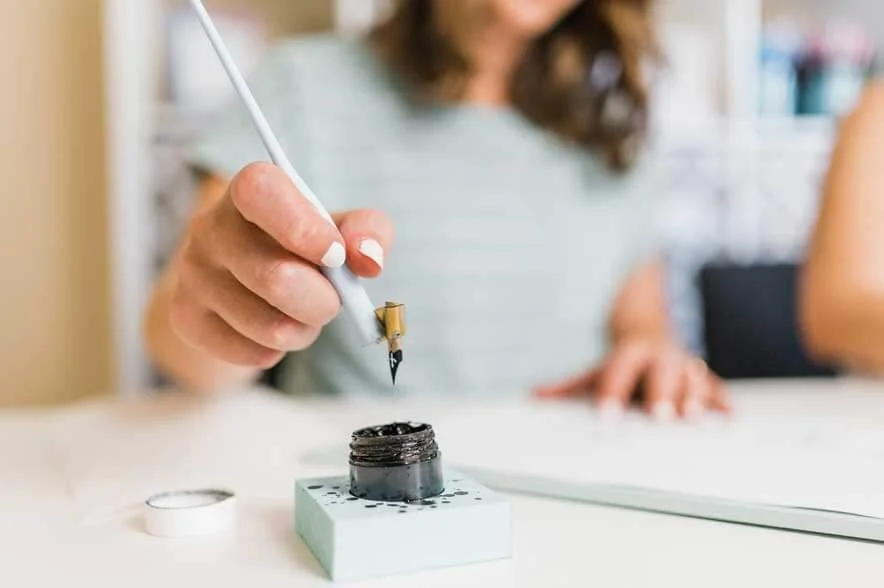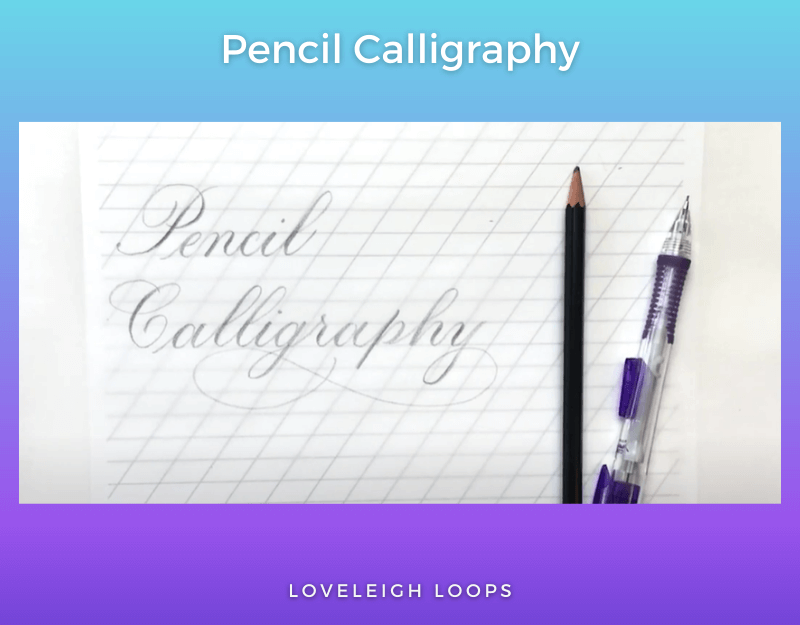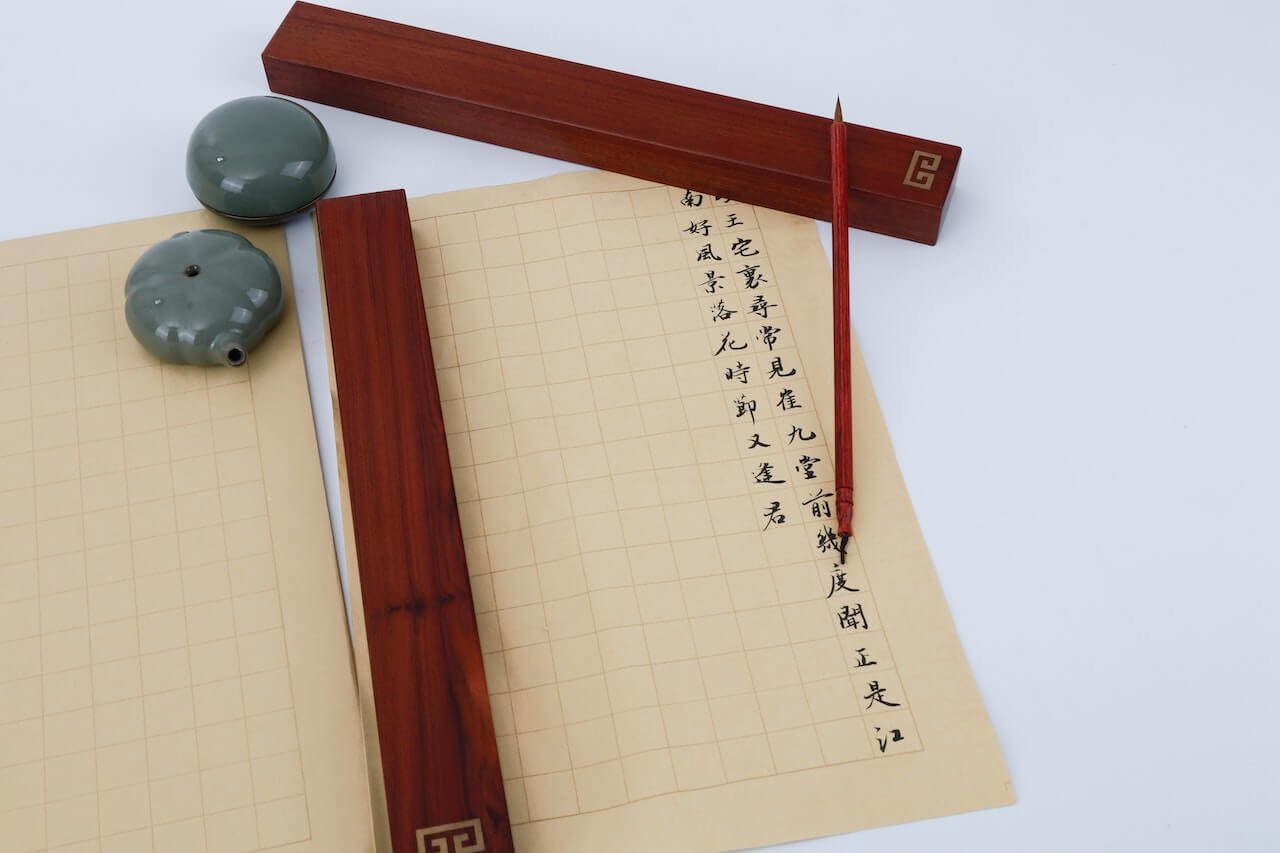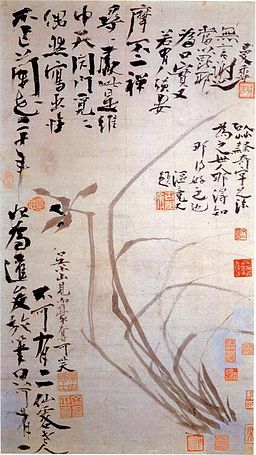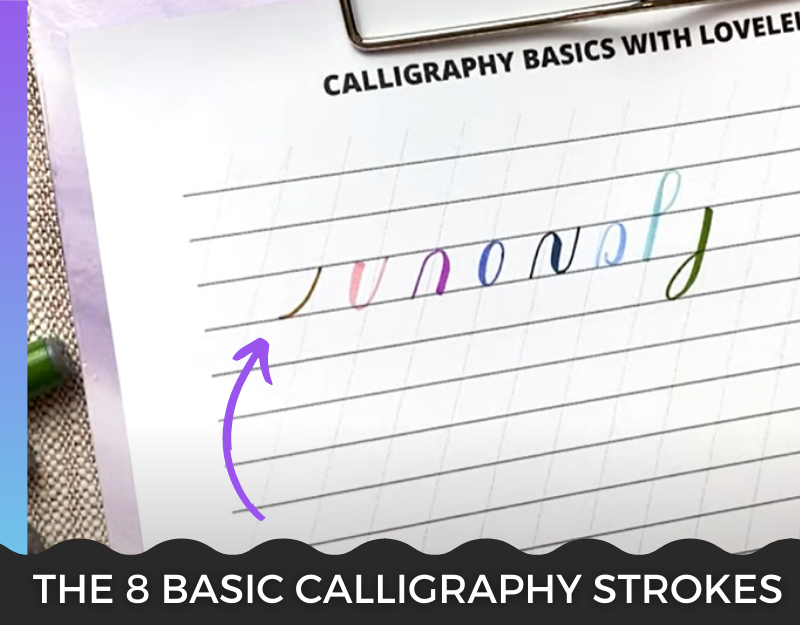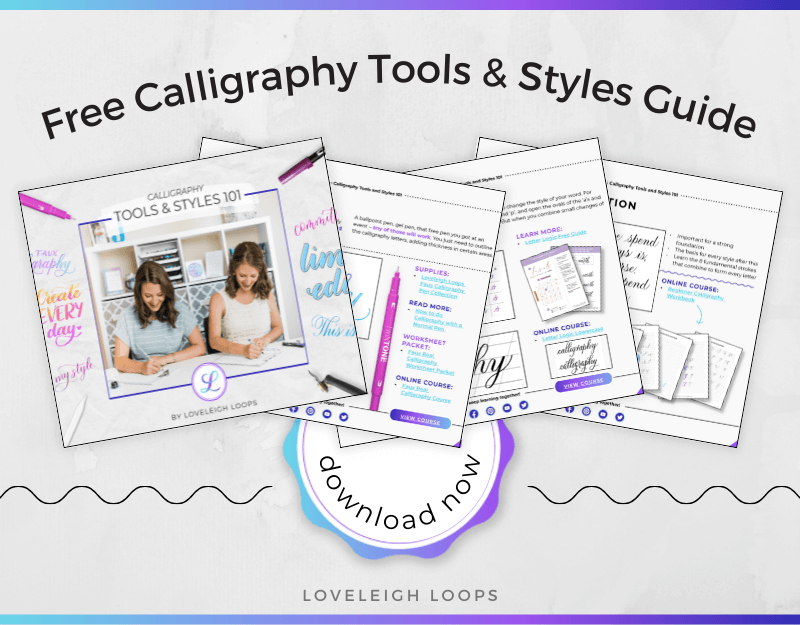Different Calligraphy Types: Styles, Tools + How To Learn
Every time you sit down with a sheet of paper with your calligraphy supplies, you’re participating in a millennia-old tradition that dates back to the beginning of written language.
Calligraphy can feel like a solo activity, but you’re actually the latest link in a long chain that connects calligraphers worldwide.
Given the large number of different writing systems in the world (both currently utilized and historic scripts), it’s not surprising that there are many different types of calligraphy.
Regardless of your preferred style, whether it’s modern bounce lettering or working on perfecting your Copperplate form, you become part of a tradition that’s been around since the dawn of time.
Table of Contents
So how do you begin, even as a beginner? Start by understanding this art’s foundation.
Pin it for later! ↓
What Is Calligraphy?
Calligraphy, or the art of beautiful handwriting, is a very broad term that encompasses what can only be described as a global tradition.
With the earliest examples of calligraphy going back thousands of years, the art of writing texts that are written beautifully and arranged according to ideals of harmony has been around for a long time.
Calligraphy is not only an ancient artistic expression, it’s also an art form that has been practiced all around the world.
Calligraphy connects you to calligraphers worldwide
From Chinese characters in the east to Mayan hieroglyphs in the west, from European manuscripts to Egyptian hieroglyphs, calligraphy has been practiced by virtually every civilization that used a system of written word.
Today, let’s look at some of the different types of calligraphy and steps that you can take today to join in yourself (even if you don’t have any supplies yet).
Example of Islamic calligraphy from the Alhambra in Granada, Spain
You may also like: Our Favorite Calligraphy Supplies
What Are The Different Types Of Calligraphy?
Calligraphy is a very broad term that is used to describe the work of anyone trying to create writing as beautifully and harmoniously as they can, while still writing text that’s easy to read.
Since calligraphy is a form of writing, you can organize different types of calligraphy by alphabet type (Latin, Greek, Hebrew, etc.) or by even broader geographic regions.
Most commonly, calligraphy is divided up into 3 different categories:
Western calligraphy
Eastern calligraphy
Arabic or Islamic calligraphy
Each different type of calligraphy has its own characteristics and is normally done with different tools.
Each type of calligraphy also has its own different styles and varieties, and these are just the broadest umbrella terms.
You may also like: The History Of Calligraphy
Let’s break down these different types of calligraphy starting at the top of the list.
And never feel alone on your calligraphy journey again. Join our Facebook group to meet your new friends.
Western Calligraphy
As for us (Jillian and Jordan - hi!!) here at Loveleigh Loops, we’ve been practicing western calligraphy since we were children, and have taught it to thousands of students in more than 100 countries.
As the name suggests, western calligraphy describes calligraphy as it’s done in the western world. To be more precise, it’s a collective term for any lettering style that primarily has the Latin alphabet at its core.
The origins of western calligraphy go back to Roman times. It was during these times that the first bibles were copied by hand and scribes were trying to perfect their handwriting.
From beautifully illustrated medieval manuscripts to elegant manuals on Spencerian penmanship, multiple scripts were developed over the years.
Example of the Spencerian script
Both traditional scripts and modern variations are still put to good use, even to this day.
You’ve probably already passed some examples of this in your life today without even realizing it:
The greeting card section at Target
Your doctor’s office (the diploma on the wall)
Illustrated quotes on Pinterest or Instagram
Speaking of which... Where do you like to hang out online? We’d love to see you there!
To us, it’s exactly the practical use and the variety of styles that makes calligraphy both exciting and interesting to study and practice.
Given that you’re reading this blog post about the different types of calligraphy in English, which uses the Latin alphabet, the main focus of this guide will be on the variations of western calligraphy and how to learn them.
But lots of fun facts on eastern and Arabic calligraphy coming up in a minute!
Example of western calligraphy
You may also like: Guide To World Calligraphy Day
Types Of Western Calligraphy
Although there are many scripts, the world of western calligraphy can be divided into three main types: traditional, modern and faux calligraphy.
Traditional Calligraphy
Writing in a traditional script means following specific rules. From rules on the proportions of letters to writing your letters at a specific angle (55 degrees, to be exact!), scripts such as Blackletter or Roundhand all have a proper way of doing things.
Example of traditional western calligraphy
For its aficionados, it’s exactly the traditional aspect of these scripts that makes it so fun.
You may also like: How To Introduce Kids To Calligraphy
Copperplate
Here we have the famous Copperplate script. Traditionally done with a pointed pen and ink, this way of writing was very popular during the 17th and 18th centuries.
Example of traditional calligraphy written with a pointed pen
To this day, Copperplate still has lots of fans around the world. People are drawn to the elegance of the script and use it to create beautiful designs for quotes or wedding invitations.
To the untrained eye, it could just look like cursive writing, but this isn’t an ordinary cursive or italic script.
Traditionally, a calligrapher uses a pointed pen to write in the Copperplate script. Through careful control of the nib, they are able to create the characteristic thick and thin strokes (downstrokes and upstrokes).
A more advanced extension of traditional Copperplate calligraphy is Copperplate flourishing.
Example of traditional calligraphy with a pointed pen compared to flourished calligraphy with brush pens
You may also like: How To Use A Brush Pen
At Loveleigh Loops, we especially love the flowing lines and flourishes that are common in Copperplate!
How To Learn Copperplate Calligraphy
Copperplate calligraphy may seem intimidating, but you can start learning and practicing today. Grab a pencil, a piece of paper and follow these steps for practicing Copperplate calligraphy in our practice guide.
We encourage anyone that’s interested in not just learning but mastering Copperplate to check out our course Calligraphy On Point.
Student review from our Calligraphy On Point course
What students have said:
"I wasted time teaching myself without much luck. Getting it right requires lots of practice and the proper guidance, and I get that from Jordan and Jillian. They’re both skilled and patient."
Blackletter Or Gothic Script
Many of you will have seen examples of writing in any of the Gothic scripts on documents or maybe even on a trip to a museum in a medieval manuscript.
Blackletter is also a popular calligraphy font used in newspapers.
Example of blackletter calligraphy. Photo by Lina Kivaka on Pexels
During medieval times, scribes developed this script to copy or create texts that were often beautifully illustrated.
Traditional scripts like this often require equally traditional, specialized tools to create the letters and Gothic is no exception. In a Gothic calligrapher’s toolbox, you would find ink, a broad edge nib, and high-quality calligraphy paper.
Gothic is a beautiful example of a very old tradition that’s being kept alive by its enthusiasts. With its reputation of being difficult to learn, budding calligraphers might look elsewhere for their first letters.
Although we don’t actively practice Gothic calligraphy ourselves, at Loveleigh Loops we certainly appreciate it as an artform.
How To Learn Blackletter Calligraphy
We don’t personally teach blackletter calligraphy, but those interested in learning should learn from our fellow calligraphy teacher Jake Rainis and his ultimate Blackletter calligraphy guide. Digital calligraphers can check out our friend Tamer at the blackletterfoundry.
Modern Calligraphy
Paradoxically, modern calligraphy can be seen as both similar and different from the more traditional scripts.
In modern calligraphy you can use a variety of colors and special effects with the sole aim of making your creation more you.
And did we mention that you can use bright colors??
You’ll see many popular calligraphy fonts mimicking this fun style of handwriting, but you don’t need a font to achieve this result yourself!
In modern calligraphy, you also follow a set of strict rules - but the difference is that they’re completely set by you. You’re in full control of letter proportions, angle, color, consistency etc.
Example of modern calligraphy done with a brush pen
Unlike mimicking an existing, traditional script, modern calligraphy aims to develop a style that’s unique to you. Through modern lettering, you have the freedom to color outside the lines and really explore any creative avenue that interests you.
You may also like: How To Use Brush Pens
How To Learn Modern Calligraphy
Toss the rules and guidelines out the door (or at least some of them) by putting your own creative spin on things. While modern calligraphy has its foundations in the conventional script, it's left to the individual calligrapher to decide what rules to keep and which to ditch.
Learn how to develop your own unique calligraphy style in our Style Study Bootcamp. You’ll go beyond just the fundamentals of good design into really understanding what sets different styles apart.
What you’ll learn in the Style Study Bootcamp
Bounce Lettering
In most conventional scripts, many aspects of your letters (such as height and spacing) are clearly defined. The most basic foundation of practice is having all letters sit on the baseline (the bottom line that you write on).
Bounce lettering throws that out the window!
See how it’s done:
No longer are you limited to having all your letters sit on the baseline or making them all the same height.
How To Learn Bounce Lettering
Ready to get bouncing?!
Start with our bounce lettering tutorial, or dive in with our complete bounce lettering course.
Example of bouncing lettering practice from bounce lettering course
iPad Calligraphy
Calligraphy doesn’t get any more modern than doing it on an iPad.
iPad lettering has skyrocketed in popularity thanks to a few factors:
The accessibility. Buying an iPad is no small investment, but it does have the convenience of being a popular tool outside of this hobby (unlike buying a specially-designed digital drawing tablet, for example)
Robust representation on Instagram, Pinterest and TikTok
Most notably, the ease of being able to practice anywhere, anytime, without any mess (we’re looking at you, inkwells!)
Ease is just the tip of the iceberg when it comes to the benefits of digital lettering.
How To Learn iPad Calligraphy
Fear not if you don’t consider yourself to be tech-savvy; you can still learn iPad lettering with the right help.
Get instant access and start practicing right now with our ABCs of Procreate iPad Calligraphy Course.
Student review from our ABCs of Procreate course
What students have said:
“I can already see a HUGE difference just after a week. Thank you!"
Faux Calligraphy
Faux calligraphy, or fake calligraphy, is a style of calligraphy that focuses on creating something that looks like calligraphy rather than engaging in the actual thing.
The secret to faux calligraphy is that you’re actually drawing the letters out and then drawing in the thicker strokes after writing.
Faux calligraphy example
This is also known as hand lettering, which distinguishes it from an authentic calligraphy style because it’s not technically a true form of calligraphy. It’s more calligraphic than calligraphy.
That point aside, the things you can do with faux calligraphy are truly impressive and it is an easy calligraphic starting point for your lettering journey.
Learn more in our faux calligraphy tutorial:
How To Learn Faux Calligraphy
The ease of this style is precisely why we created an entire free course on faux calligraphy!
If you’re a beginner, or if you’re just more interested in the end result than the process of getting there, faux calligraphy could be your jam!
Western Calligraphy Tools
People use various different tools for western calligraphy. It shouldn’t come as a surprise given the large variety in this calligraphy type!
These tools have overlap with eastern and Arabic calligraphy, but we’ll give examples in the context of western calligraphy.
Dip Pen or Pointed Pen
Most traditional scripts use a modern version of the same tools people used back in the day. While there is actually still a small minority of people that use quills for their calligraphy, most people have upgraded to a pointed pen.
Pointed pen being dipped in an inkwell
A pointed pen consists of a nib and a pen holder and needs to be dipped in ink in order to write. Although it takes some time to learn how to use it, a pointed pen is still best for conventional calligraphy!
Watch pointed pen in real-time:
You may also like: Copperplate Capital Letters Guide
Brush Pen
A brush pen is exactly what the name suggests: a combination of a brush and a pen. It’s basically a marker (translation: ink inside) with a flexible tip that resembles a brush.
Brush lettering example
With brush pens, you can create thick and thin lines through differences in pressure. In addition, you can use them to create various special effects such as blending colors together or creating spectacular watercolor backgrounds!
Favored for modern calligraphy, brush pens come in lots of different colors and sizes. It’s exactly this variety that makes them such an amazing tool for calligraphy.
They present the best of both worlds as you can practice traditional calligraphy skills but without the hassle of using a traditional writing tool.
Learn more in our intro to brush pen tutorial:
Ordinary Pencil
That’s right! Not all calligraphy is done with specialized tools. The humble pencil can do calligraphy as long as you know how to use it.
Example of pencil calligraphy
Doing calligraphy with a pencil is perfect for practicing. Learning your basic strokes or getting the hang of flourishing takes time and practicing with a normal pencil on normal paper will save you more money than you might think.
While you can start building your calligraphy foundation at any moment using a pencil, there are still nuances to pencil types:
Use soft lead if you can
Don’t use a sharpened point, but instead opt for a rounded tip
With a pencil in hand, your calligraphy foundation is just waiting to be built.
Learn more in our pencil tutorial:
iPad, Apple Pencil And Procreate App
Calligraphy’s come a long way from parchment and quills. Some modern calligraphers whip out their Apple Pencils while on a subway ride to work, while kids are down for their nap time or on a quiet park bench.
The joy of being able to take calligraphy with you anywhere.
That’s what we love about digital lettering, and precisely the opportunity and flexibility that’s earned iPad calligraphy a spot at the table as one of the most valuable types of calligraphy.
You may also like: How To Make Your Digital Calligraphy Look More Advanced
The precise tools required are:
An iPad - just choose the right one
An Apple Pencil - don’t get a generic version or it won’t have the pressure sensitivity that’s required to get thick downstrokes
See how to get started with Procreate even as a total beginner:
That concludes our tour in the West, and now this wonderful calligraphic ride is taking us to the East.
Eastern Calligraphy
Calligraphy has been popular in Asia for centuries and originated in China. Countries like Japan, China, and Korea have long-standing calligraphy traditions.
Asian calligraphy is traditionally done using Chinese characters. In Chinese calligraphy, as with most Chinese art, inspiration comes from nature and every piece of calligraphy should have a rhythm and vibrancy to it.
Photo by Feng Zou on Pexels
If you’re not familiar with these calligraphy alphabets, it’s easy to be mesmerized by the complexity of the characters alone, let alone the discipline that goes into the strokes and control of the ink.
Chinese calligraphy example from the Wikipedia Commons.
Fun fact about eastern calligraphy: historically, it was considered a “supreme art form” in Korea, Japan and China.
We couldn’t agree more!
To learn more about the traditions, modern uses and history of eastern calligraphy, check out these resources:
Eastern calligraphy guide from the Association For Asian Studies
The Encyclopedia Britannica’s page on Chinese, Korean and Japanese calligraphy
Wikipedia’s page on East Asian calligraphy
Arabic Or Islamic Calligraphy
Arabic calligraphy is also sometimes referred to as Islamic calligraphy as it developed alongside Islam. Like Western calligraphy, it used a variety of unique pens as the practice evolved and there are both traditional and modern interpretations used to this day.
Example of Arabic calligraphy at The Museum Of The Future in Dubai. Photo by Denys Gromov on Pexels
Fun fact about Arabic calligraphy: it’s written from right to left and there are no capital letters!
Arabic calligraphy was also one of the first instances of calligraphy being printed on coins.
Arabic calligraphy example from the Wikipedia Commons
To learn more about the history, traditions and modern uses of Arabic calligraphy, check out these resources:
The Encyclopedia Britannica’s page on Arabic calligraphy
Wikipedia’s page on Islamic calligraphy
Example of Islamic calligraphy from the Alhambra in Granada, Spain
Which Of The Different Types Of Calligraphy Should You Learn?
Have the different forms of calligraphy caught your attention and now you’re ready to try for yourself?
The first step to learning modern western calligraphy is simple: learn the basic strokes.
The 8 basic calligraphy strokes written out on guide sheets
These 8 basic calligraphy strokes are the foundation of the entire lowercase calligraphy alphabet. Instead of writing words or even entire letters at once, such as in cursive writing, you build each letter stroke by stroke.
Use our free practice sheets to start learning the basic strokes right now.
But where will your basic strokes take you? To perfecting the flawless flourish, the bubbliest bounce lettering or the most idiosyncratic iPad calligraphy?
Read a deeper dive into the different tools and styles in our Calligraphy Tools & Styles 101 Guide:
Different Types Of Calligraphy Courses
Are you ready to learn calligraphy as a beginner or improve your craft? Your best learning experience is one of our calligraphy courses, which gives you a clear curriculum, practice schedule, free worksheets and more.
Which one excites you the most?
Beginner Calligraphy Workbook (interactive workbook with video tutorials)
How To Master iPad Calligraphy (course bundle!)
Loveleigh University (complete calligraphy course and membership)
Whatever type of calligraphy interests you most, we’re just glad you came to celebrate this amazing art with us here are Loveleigh Loops. Happy lettering!
